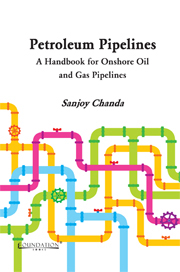Book contents
- Frontmatter
- Contents
- List of Tables and Figures
- Preface
- 1 Introduction: Some Basic Facts about Pipelines
- 2 Pipeline Design and Engineering
- 3 Pipeline Construction
- 4 Pre-commissioning and Commissioning of Pipelines
- 5 Operation and Maintenance of Cross-country Pipelines
- 6 Pipeline Corrosion and its Mitigation
- Bibliography
- Index
6 - Pipeline Corrosion and its Mitigation
Published online by Cambridge University Press: 05 September 2013
- Frontmatter
- Contents
- List of Tables and Figures
- Preface
- 1 Introduction: Some Basic Facts about Pipelines
- 2 Pipeline Design and Engineering
- 3 Pipeline Construction
- 4 Pre-commissioning and Commissioning of Pipelines
- 5 Operation and Maintenance of Cross-country Pipelines
- 6 Pipeline Corrosion and its Mitigation
- Bibliography
- Index
Summary
Introduction
A general definition of corrosion is the degradation of a material caused by its environment. A certain amount of energy input is required to extract a metal from its ore. A pure metal or its alloys is thus in a state of high energy which is a state that is thermodynamically unstable. Converting iron ore into steel is like taking a rock and rolling it uphill. Once released, it will roll down the hillside and come to rest at the bottom from where it had been rolled up. Unless protected against natural elements, processed steel tends to go back to a lower energy state – an oxide or some other compound. The process by which metals convert to low energy compounds is called corrosion. Corrosion control is the prevention of this deterioration.
Steel pipelines are subjected to both internal and external corrosion. Unless effectively controlled, corrosion may prove to be very costly for the pipeline owner. Corrosion has the following detrimental effects:
• Damages and weakens the pipeline
• Necessitates costly repair or replacement
• Reduces life of pipeline
• Causes loss of product
• Damages property of others
• Causes considerable downtime for the pipeline – also causing closure of downstream facilities
• Causes damage to environment
• Compromises safety to personnel
• Causes loss of public goodwill
- Type
- Chapter
- Information
- Petroleum PipelinesA Handbook for Onshore Oil and Gas Pipelines, pp. 183 - 218Publisher: Foundation BooksPrint publication year: 2013

